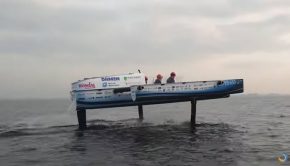Ten Great Modern Sailing Innovations
Published on May 29th, 2013
By Zuzana Prochazka, Boats.com
My colleague, power-boater Lenny Rudow, wrote a discussion-provoking article on 10 Great Modern Boating Inventions and Innovations. He started with the concept of cup holders, which seemed strange until I thought about our latte-consuming culture and realised he might be right in his priorities. However, a different set of innovations have specifically and significantly changed sailing and cruising in the past few decades. Here are some that ensure we will never sail the same old way again.
1. Keel, hull, and transom design
Gone are the days of integrated full keels and skeg-hung rudders. Bolt-on deep and shoal draft keels with bulbs and wings and deep spade rudders are what keep our sailboats upright and tracking these days. The results of this evolution have included the ability of the boat to turn in its own length, and the likelihood of backing in a straight line — which is a bit of a sailing boat miracle.
Many production boats today have introduced hard chines with the beam carried well aft. These boats sail flatter because they lean and stabilise on that hard chine when heeling, which has made family outings a bit more comfortable. The beamy designs have also created large volumes below, which has changed the layout and accommodation and enhanced comfort. Leaps and bounds have been made in transom technology, as well, including the electric drop-down transom of the Beneteau Oceanis models and the full walk-through transom of the Sense series (see Sense 55: Luxury Beneteau Range gets Larger), where seats lift to open up an almost catamaran-like cockpit.
2. Building materials and techniques
In the 1960s fibreglass forever changed the world of boating; strength was attributed to heft, so inch and a half thick solid glass hulls were the norm. Now resin infusion and vacuum bagging, which were first used in France in the 1970s, have gained acceptance and are widely-used boat building methods. Vacuum-bagging has a wet laminate cured under vacuum, which pulls out the excess resin and creates a light and strong high fibre content laminate. Resin infusion is a variation of vacuum bagging in which the resin is infused into the dry laminate after the vacuum is created. Both methods produce clean and light fibreglass parts that are strong and require little fairing or sanding.
3. Sail and rigging materials
Modern materials have reached beyond hull construction to the rig and sails that power these new boats. Any serious race boat is likely to sport a suit of laminated sails which stretch less and delivery superior shape and therefore better performance. Because laminate sails tend to last only a couple years and suffer from mildew between the layers, cruisers still opt for more traditional sail cloth like Dacron, which is more UV resistant. Lightweight nylon spinnakers and gennakers are carried by both.
Huge advances have also been made in the lines used for running rigging. High-tech lines like Spectra and Dyneema are ultra-high-molecular-weight polyethylene fibres that have a high strength to weight ratio, excellent abrasion and UV resistance, and reduced flex fatigue. They can manage thousands of pounds of load (good for sheets for large sails) and have little stretch or creep (excellent for halyards).
Read on: http://uk.boats.com/boat-content/2013/05/10-great-modern-sailing-innovations/







 We’ll keep your information safe.
We’ll keep your information safe.